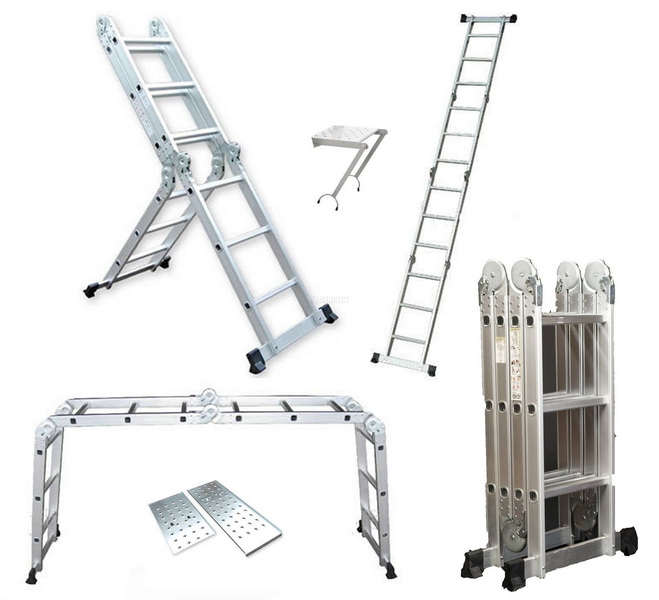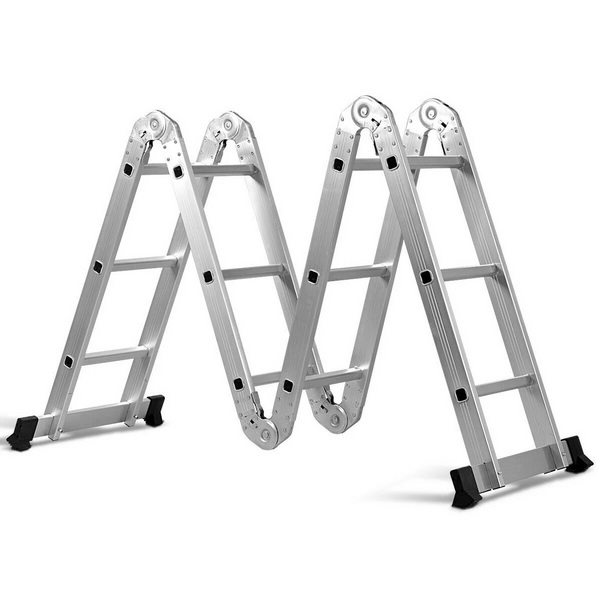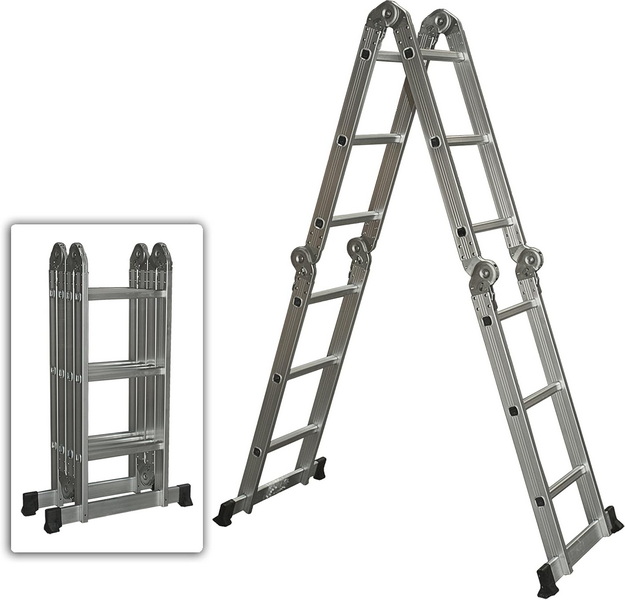Content Menu
● Introduction
● What Is a Ladder That Folds Into Scaffolding?
● Key Features and Mechanisms
● Advantages Over Traditional Ladders
>> 1. Enhanced Stability and Safety
>> 2. Increased Work Space
>> 3. Versatility
>> 4. Portability and Storage
>> 5. Time and Cost Savings
>> 6. Ergonomics and Comfort
● Limitations and Considerations
>> 1. Height Restrictions
>> 2. Load Capacity
>> 3. Platform Size
>> 4. Assembly Complexity
>> 5. Lack of Built-in Guardrails
>> 6. Not for All Surfaces
● Safety: Ladder That Folds Into Scaffolding vs. Traditional Ladders
>> Traditional Ladders
>> Ladder That Folds Into Scaffolding
● Real-World Applications and User Scenarios
>> Painting and Decorating
>> Home Maintenance
>> Construction and Renovation
>> Outdoor Projects
>> DIY and Hobby Projects
● Maintenance and Inspection Tips
● How to Choose the Right System
● Cost and Value Considerations
● User Reviews and Industry Feedback
● Conclusion
● FAQ
>> 1. Is a ladder that folds into scaffolding safer than a traditional ladder?
>> 2. What are the main limitations of a ladder that folds into scaffolding?
>> 3. Can one person set up and use a ladder that folds into scaffolding?
>> 4. Are there specific safety standards for these ladders?
>> 5. When should I choose a traditional ladder instead?
With the evolution of construction tools and the growing demand for versatility, the ladder that folds into scaffolding has become an increasingly popular choice among professionals and DIY enthusiasts. But is this hybrid solution genuinely better than traditional ladders? This comprehensive article explores the features, benefits, limitations, and safety considerations of ladders that fold into scaffolding, comparing them with standard ladders.

Introduction
Ladders have long been a staple on worksites and in homes, valued for their portability and simplicity. However, as projects become more complex and safety standards rise, the need for more stable and adaptable access solutions has grown. Enter the ladder that folds into scaffolding—a multipurpose tool that promises to combine the best of both worlds. But does it truly outperform the traditional ladder in practice? Let's break down the facts.
What Is a Ladder That Folds Into Scaffolding?
A ladder that folds into scaffolding is a combination or multiposition ladder engineered to transform from a standard ladder into a low-level scaffold platform. Typically constructed from lightweight aluminum, these ladders feature locking hinges, adjustable legs, and accessories such as planks or platforms that allow the user to create a stable working surface between two ladder sections.
Common Configurations:
- Step ladder
- Extension ladder
- Scaffold platform (using two ladder sections and a plank)
- Staircase ladder (for uneven surfaces)
Key Components:
- Hinged, multi-position ladder sections
- Locking mechanisms for stability
- Optional telescoping or fixed-length planks
- Slip-resistant feet
Key Features and Mechanisms
- Folding Design: Allows the ladder to collapse for compact storage and transport, and to unfold into various configurations.
- Multi-Functionality: Serves as a step ladder, extension ladder, or scaffold platform.
- Adjustable Height: Telescoping legs and planks enable use at different elevations.
- Lightweight Construction: Most are made of aluminum, balancing strength and portability.
- Safety Locks: Secure hinges and locking pins prevent accidental collapse during use.
- Rubberized Feet: Provide grip and stability on various surfaces.
- Support for Accessories: Some models support guardrails, tool trays, or additional planks for wider platforms.
Advantages Over Traditional Ladders
1. Enhanced Stability and Safety
A ladder that folds into scaffolding offers a wide, flat platform for standing, reducing fatigue and the risk of falls compared to balancing on narrow rungs. Guardrails and toe boards may be added for extra protection, especially when working at higher elevations.
2. Increased Work Space
Traditional ladders limit users to a narrow rung, restricting movement and making it difficult to handle tools and materials. The scaffold mode provides ample space to move, store tools, and work more efficiently.
3. Versatility
With a single tool, users can switch between ladder and scaffold modes, adapting to a wide range of tasks—painting, drywall, window installation, electrical work, and more.
4. Portability and Storage
Folding mechanisms allow for compact storage and easy transport, making these ladders ideal for contractors and DIYers with limited space.
5. Time and Cost Savings
One tool replaces several, reducing the need to purchase, maintain, and store multiple pieces of equipment. Quick conversion between modes cuts down on setup time.
6. Ergonomics and Comfort
Standing on a platform is far more comfortable for long tasks than standing on ladder rungs. This reduces leg and back fatigue and allows for more productive work sessions.

Limitations and Considerations
While a ladder that folds into scaffolding offers many benefits, it's not always the best choice for every job.
1. Height Restrictions
These systems are typically limited to lower working heights (often under 20 feet), making them unsuitable for high-elevation projects.
2. Load Capacity
While many can support up to 375–500 lbs, they may not accommodate multiple workers or heavy equipment like full-size scaffolding.
3. Platform Size
The scaffold platform is narrower and shorter than traditional scaffolding, limiting movement and storage space for tools.
4. Assembly Complexity
First-time users may find the conversion process confusing. Proper setup is essential for safety, and skipping steps can lead to instability.
5. Lack of Built-in Guardrails
Many models do not include guardrails as standard, requiring additional accessories or personal fall protection for higher platforms.
6. Not for All Surfaces
While most models have rubber feet for grip, using them on very uneven or soft ground can compromise stability unless the system is specifically designed with adjustable feet.
Safety: Ladder That Folds Into Scaffolding vs. Traditional Ladders
Traditional Ladders
- Pros: Simple, quick to deploy, lightweight.
- Cons: Narrow rungs cause fatigue, limited space for tools, higher risk of falls due to instability and overreaching.
Ladder That Folds Into Scaffolding
- Pros: Wide, stable platform reduces fatigue and fall risk; can be used for longer tasks; less repositioning needed.
- Cons: Still requires careful setup and inspection; platform height is limited; may lack guardrails unless added.
Safety Tips for Both:
- Always follow manufacturer instructions.
- Inspect before each use for damage or wear.
- Never exceed weight limits.
- Use on level, stable ground.
- For platforms over 10 feet, use guardrails or fall protection.
Real-World Applications and User Scenarios
Painting and Decorating
A ladder that folds into scaffolding allows painters to move freely along walls or ceilings, keeping paint cans and tools within easy reach.
Home Maintenance
From cleaning gutters to installing lighting, the scaffold platform offers a stable base for extended tasks without constant repositioning.
Construction and Renovation
Electricians, drywall installers, and carpenters benefit from the versatility, using the ladder in scaffold mode for ceilings or as a standard ladder for quick access.
Outdoor Projects
Landscapers and exterior contractors use these ladders for fence painting, hedge trimming, and light construction, especially where portability is key.
DIY and Hobby Projects
Hobbyists and homeowners use these ladders for everything from hanging holiday lights to building garden structures, appreciating the ease of conversion and stable platform for intricate work.
Maintenance and Inspection Tips
- Inspect Before Each Use: Check for cracks, bent parts, or loose fittings.
- Clean Regularly: Remove dirt and debris from hinges, rungs, and planks.
- Lubricate Moving Parts: Use manufacturer-approved lubricants for hinges and locking mechanisms.
- Replace Worn Components: Don't use the system if any part is damaged or missing.
- Store Properly: Keep in a dry, secure area to prevent rust or corrosion.
- Check Accessories: Ensure any added guardrails, trays, or planks are in good condition and properly attached.
How to Choose the Right System
When selecting a ladder that folds into scaffolding, consider:
- Weight and Portability: Can you easily carry and maneuver the ladder and plank?
- Platform Size: Is the scaffold platform wide enough for your tasks?
- Load Capacity: Does the system support your weight plus tools/materials?
- Ease of Assembly: Are the locking mechanisms and brackets intuitive?
- Material: Aluminum is lightweight and rust-resistant; fiberglass is non-conductive for electrical work.
- Brand Reputation: Choose reputable brands known for safety and durability.
- Accessories: Look for compatible guardrails, tool trays, and storage solutions.
Cost and Value Considerations
While the initial investment for a ladder that folds into scaffolding may be higher than for a basic traditional ladder, the value comes from its versatility and the ability to replace multiple tools. Consider the following:
- Long-Term Savings: Fewer tools to buy, store, and maintain.
- Reduced Downtime: Quick conversion between modes saves time on the job.
User Reviews and Industry Feedback
Many users—both professionals and DIYers—report high satisfaction with ladders that fold into scaffolding, citing:
- Ease of Use: Most find the conversion process intuitive after initial setup.
- Increased Productivity: The ability to work more comfortably for longer periods.
- Portability: Easy transport between job sites.
- Safety: Greater confidence on a stable platform.
However, some note the limitations in height and platform size, and recommend keeping a traditional ladder on hand for quick jobs or tight spaces.
Conclusion
A ladder that folds into scaffolding is a versatile, portable, and efficient tool that often outperforms traditional ladders for many tasks—especially those requiring extended work at height, stability, or frequent repositioning. Its wide platform, adaptability, and compact storage make it ideal for both professionals and DIYers. However, it is not a complete replacement for traditional ladders or full-size scaffolding in every situation. For high-elevation or heavy-duty projects, or where multiple workers are involved, traditional solutions may still be preferable. Ultimately, the best choice depends on your specific needs, workspace, and safety requirements.

FAQ
1. Is a ladder that folds into scaffolding safer than a traditional ladder?
Generally, yes. The scaffold platform provides greater stability, a larger work area, and reduces fatigue and fall risk. However, proper setup and use are essential for safety.
2. What are the main limitations of a ladder that folds into scaffolding?
They are limited in height, platform size, and load capacity compared to full scaffolding. They may also lack built-in guardrails and are best suited for one-person use.
3. Can one person set up and use a ladder that folds into scaffolding?
Yes, most modern systems are designed for solo setup and use. Components are lightweight and feature intuitive locking mechanisms, making assembly straightforward for one person.
4. Are there specific safety standards for these ladders?
Yes. Follow OSHA and manufacturer guidelines, including guardrails for platforms over 10 feet, proper load limits, and regular inspections.
5. When should I choose a traditional ladder instead?
For quick access at moderate heights, in very tight spaces, or when portability is the only concern, a traditional ladder may be preferable. For extended work, stability, or tool storage, the folding scaffold ladder is superior.






















